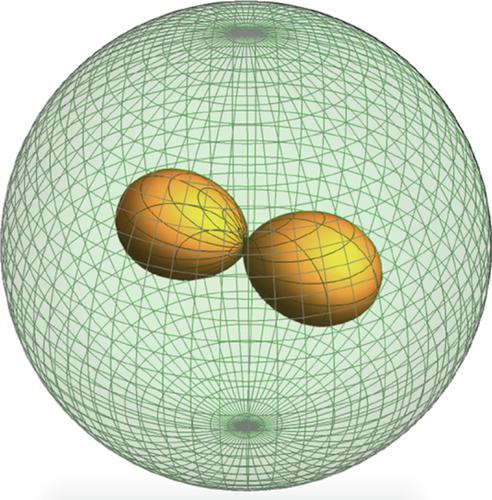当前位置:
X-MOL 学术
›
Int. J. Quantum Chem.
›
论文详情
Our official English website, www.x-mol.net, welcomes your
feedback! (Note: you will need to create a separate account there.)
Electronic structure of first and second row atoms under harmonic confinement
International Journal of Quantum Chemistry ( IF 2.3 ) Pub Date : 2019-12-19 , DOI: 10.1002/qua.26132 Andrés Robles‐Navarro 1, 2 , Patricio Fuentealba 1, 2 , Francisco Muñoz 1, 2 , Carlos Cárdenas 1, 2
International Journal of Quantum Chemistry ( IF 2.3 ) Pub Date : 2019-12-19 , DOI: 10.1002/qua.26132 Andrés Robles‐Navarro 1, 2 , Patricio Fuentealba 1, 2 , Francisco Muñoz 1, 2 , Carlos Cárdenas 1, 2
Affiliation

|
Atoms under pressure undergo a series of processes and modification of its electronic structure. Examples are the spontaneous ionization, stabilization of excited-state configurations that result in a level-crossing with the ground state of the free atom, and contraction of atomic shells. In this work, we do a systematic study of the effects of confinement with harmonic potential on the electronic structure of atoms from H to Ne. Dynamic and static correlation is taken into account by performing CCSD and CASSCF calculations, respectively. Because the strength of harmonic confinement cannot be translated into pressure, we envisioned a "calibration" method to transform confinement into pressure. We focused on the effect of confinement on: i) changes of electron distribution and localization within the $K$ and $L$ atomic shells, ii) confinement-induced ionization pressure, iii) level crossing of electronic states, and iv) the electron correlation energy. We found that contraction of valence and core shells are not negligible and that the use of standard pseudopotentials might be not adequate to study solids under extreme pressures. The critical pressure at which and atom ionizes follows a periodic trend, and it ranges from $28$ GPa for Li to $10.8$ TPa for Ne. In Li and a Be, pressure induces mixing of the ground state configuration with excited states. At high pressure, the ground state of Li and Be becomes a doublet and a triplet with configurations $1s^22p$ and $1s^22s2p$ respectively. The potential consequences of these changes of configuration on the chemistry of Be are discussed. Finally, the changes in the amount of electron correlation are characterized and analyzed in terms of the RPA approximation. For atoms with fewer electrons in the valence shell correlation increases, but for atoms with more electron, the increasing of kinetic energy dominates over electron correlation.
中文翻译:

谐波约束下第一和第二行原子的电子结构
原子在压力下经历一系列过程并改变其电子结构。例子是自发电离、激发态构型的稳定,导致与自由原子的基态水平交叉,以及原子壳的收缩。在这项工作中,我们系统地研究了谐波势能对原子从 H 到 Ne 的电子结构的影响。通过分别执行 CCSD 和 CASSCF 计算来考虑动态和静态相关性。由于谐波约束的强度无法转化为压力,我们设想了一种“校准”方法将约束转化为压力。我们专注于限制对以下方面的影响:i) $K$ 和 $L$ 原子壳内电子分布和定位的变化,ii) 约束引起的电离压力,iii) 电子态的能级交叉,以及 iv) 电子相关能。我们发现价态和核壳的收缩不可忽略,使用标准赝势可能不足以研究极端压力下的固体。和原子电离的临界压力遵循周期性趋势,范围从 Li 的 28 美元 GPa 到 Ne 的 10.8 美元 TPa。在 Li 和 a Be 中,压力导致基态构型与激发态的混合。在高压下,Li 和 Be 的基态变成双峰和三重峰,分别具有 $1s^22p$ 和 $1s^22s2p$ 构型。讨论了这些构型变化对 Be 化学的潜在影响。最后,根据 RPA 近似来表征和分析电子相关量的变化。对于价壳相关性中电子较少的原子增加,但对于电子较多的原子,动能的增加支配电子相关性。
更新日期:2019-12-19
中文翻译:

谐波约束下第一和第二行原子的电子结构
原子在压力下经历一系列过程并改变其电子结构。例子是自发电离、激发态构型的稳定,导致与自由原子的基态水平交叉,以及原子壳的收缩。在这项工作中,我们系统地研究了谐波势能对原子从 H 到 Ne 的电子结构的影响。通过分别执行 CCSD 和 CASSCF 计算来考虑动态和静态相关性。由于谐波约束的强度无法转化为压力,我们设想了一种“校准”方法将约束转化为压力。我们专注于限制对以下方面的影响:i) $K$ 和 $L$ 原子壳内电子分布和定位的变化,ii) 约束引起的电离压力,iii) 电子态的能级交叉,以及 iv) 电子相关能。我们发现价态和核壳的收缩不可忽略,使用标准赝势可能不足以研究极端压力下的固体。和原子电离的临界压力遵循周期性趋势,范围从 Li 的 28 美元 GPa 到 Ne 的 10.8 美元 TPa。在 Li 和 a Be 中,压力导致基态构型与激发态的混合。在高压下,Li 和 Be 的基态变成双峰和三重峰,分别具有 $1s^22p$ 和 $1s^22s2p$ 构型。讨论了这些构型变化对 Be 化学的潜在影响。最后,根据 RPA 近似来表征和分析电子相关量的变化。对于价壳相关性中电子较少的原子增加,但对于电子较多的原子,动能的增加支配电子相关性。











































 京公网安备 11010802027423号
京公网安备 11010802027423号